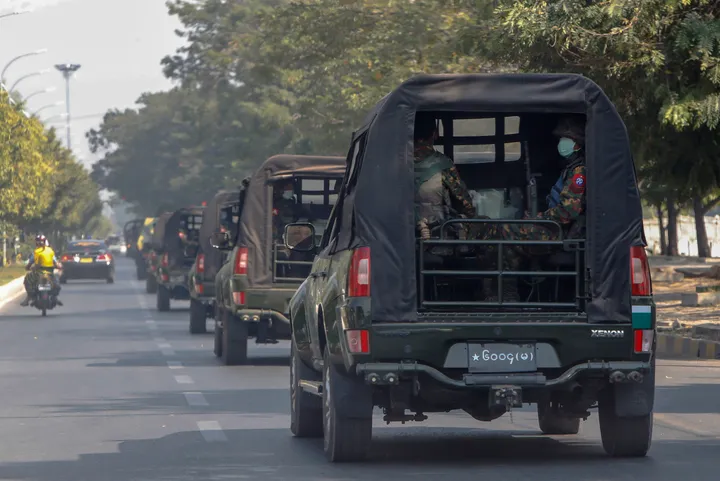The YPG in northern Syria was quick to pivot toward Damascus and forge a deal with the Assad regime on October 14 to stave off the Turkish military's cross-border operation.
Brokered by Russia, the deal is likely to dismantle the YPG's so-called self-rule in the region and demands the terror group surrender the key border towns of Manbij and Ayn al Arab (also known as Kobani) to Damascus.
It was Ankara’s unexpectedly swift operation that changed the political equation of northern Syria, raising the hopes of a homecoming for hundreds of thousands of Syrian refugees, and forcing the YPG and its parent body the PKK to renew their working relationship with Damascus.
Recognised as a terrorist organisation by Turkey, the EU and the US, the PKK ran training camps in the Syria-occupied Beqaa Valley in the 1970s, when the terror group was in its early stages. Hafez al Assad, the predecessor and father of Syrian regime leader Bashar al Assad, gave his blessing to the terror project that was aimed at Turkey.
The Ocalan period
Abdullah Ocalan, the PKK founder and leader, had long collaborated with Hafez al Assad for both external and internal purposes.
Externally, the PKK armed groups, which largely recruited its members from Syria's Kurdish population, have been mobilised against Turkey to threaten its water projects on the Euphrates River and affect the status of Hatay province, which seceded from Syria in 1938 and became part of Turkey in 1939.
“Hafez al Assad took on the PKK file to use the group as a weapon against Turkey,” said Chamseddin Hamo, a prominent Syrian Kurdish opponent, who was the chairman of the central committee of the Kurdish Union Party in Syria (PYKS), which is also known as Yekiti.
Within Syria, Assad used the terror group to suppress Kurdish people who spoke out against his regime. Ocalan repeatedly advised Syrian Kurds to remain loyal to the Assad family.
“The PKK did not belong to us. It was imposed on Kurds by force,” Hamo told TRT World in a previous interview in early 2018, while sitting at his house in Gaziantep, where he has been living since 2012.
Between the late 1970s and 1990s, Ocalan and his comrades spent nearly two decades in Syria. In light of Turkey's mounting military pressure, he was expelled from the country in 1998.
Following that, Ankara-Damascus relations improved.
The YPG period
However, the Syrian civil war completely severed Turkey-Syria ties. Ankara refused to overlook the large-scale brutality the Assad regime imposed on Syrian people and supported the armed revolution, a consequence of Assad's violent military crackdown on peaceful protesters in 2011.
To counter the growing clout of the Syrian opposition, the Assad regime utilised the PKK to create a wedge between the revolutionary forces. The PKK deployed various tactics to weaken the Syrian-Kurdish opposition that fought against the regime alongside Arabs.
“As Syrian-Kurds, we have shown our opposition to the Assad regime [in the beginning of the civil war]. The regime understood that it cannot handle Kurds by itself, so they brought the PKK from the Qandil mountains [located in northern Iraq] and supported them. Eventually, the PKK firmly settled in northern Syria,” said Osman Huseyin, a Syrian Kurdish political figure from Afrin.
Huseyin headed the Kurdish Future Movement (SPKS) in Afrin, a political movement established by Mashaal Tammo, a prominent Kurdish opinion leader and politician, in 2005.
The movement was against both the Assad regime and the PKK's influence in northern Syria. But the party’s leader, Tammo, was killed in October 2011 at the beginning of the civil war, allegedly by Assad's hitmen. The PKK was accused of enabling the assassination.
To strengthen their stranglehold on Syrian-Kurds, the Assad regime and the PKK leadership reached an understanding to establish a new militant entity named as the YPG, which was tasked with coordinating a tactical military withdrawal of regime forces from northern Syria.
In 2012, as the regime forces left northern Syria, the people of the region saw YPG's meteoric rise. The terror group was quick to establish ‘cantons’, or autonomous regions, along the border towns next to Turkey.
Under Turkish pressure
Seven years later, as Turkey's latest military operation hit the YPG hard, it again turned to Damascus for protection.
According to various reports, regime forces, along with Russian military units, are now moving into YPG-held territories under a pact Moscow recently brokered between Damascus and the YPG.
























